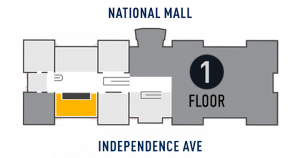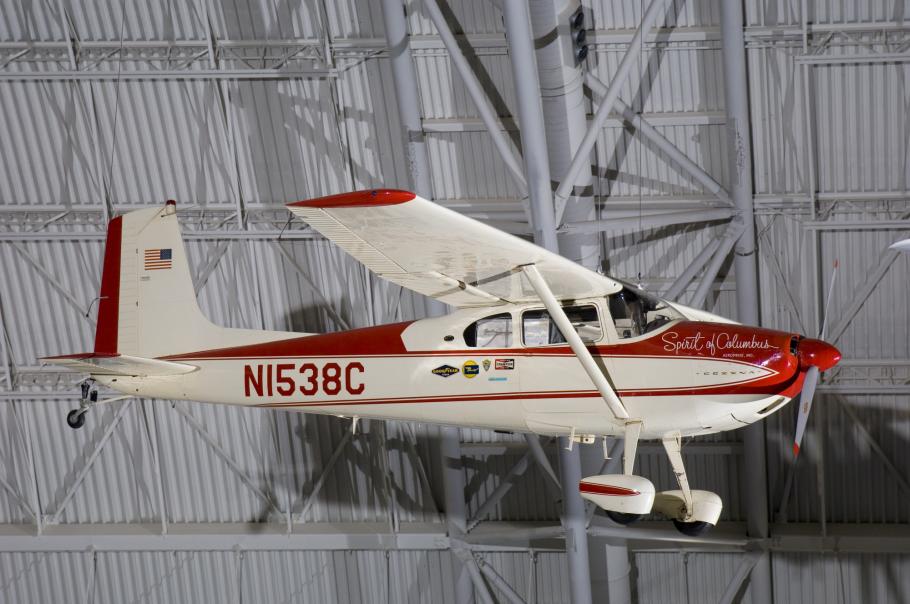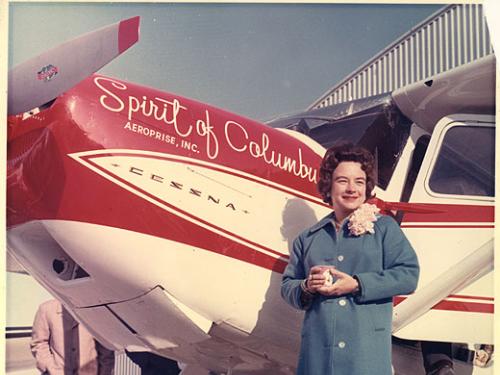A National Aeronautic Association press release, dated April 18, 1964, announced that Geraldine "Jerrie" Mock had become the first woman to pilot an aircraft around the world. Previous attempts by women, including the ill-fated 1937 flight by Amelia Earhart, were unsuccessful. When success did come, it was twenty-seven years later by a woman from Columbus, Ohio, flying a 1953 Cessna 180 single-engine monoplane, the Spirit of Columbus. Mock wrote about her exceptional solo flight in Three Eight Charlie.
The Cessna 180 series and its descendants are another great success story for Cessna Aircraft Corporation of Wichita, Kansas, and general aviation. Borrowing some features, such as flaps, from the Army's L-19 Bird Dog liaison airplane and evolving directly from the postwar Model 170B four-seat design, the 180, introduced in 1952, became a rugged four-place high-wing plane with a top speed of 165 mph. Variations on the basic airframe and 225 or 230 hp engines made it a popular bush-type aircraft in most of the undeveloped parts of the world as well as in the United States. The Model 180 was also successfully marketed as a sophisticated business and personal aircraft.
In 1956, by adding a tricycle landing gear, the180 became the Model 182 Skylane, which, with cockpit and exterior improvements, enjoyed a long initial production run as a high performance workhorse in the personal, business, and utility categories. The Cessna 185 Skywagon was introduced in 1960 with a more powerful engine for the tail dragger 180 design. Cessna built more than 6,000 of the Model 180 series aircraft and 22,000 Model 182s through 1986. It halted production of single-engine piston aircraft in the mid-1980s when a product liability crisis, a surplus of general aviation aircraft, and other economic woes threatened the future of small light planes. However, with the passage of the General Aviation Revitalization Act of 1994, the company began producing the Model 182 Skylane (and other single-engine models) again in July 1996 at a new factory in Independence, Kansas.
Cessna built 640 Model 180s in its first production year and the Spirit of Columbus was the 238th aircraft, bearing serial number 30238 and registration number N1538C. During the first ten years, several owners put 990 flying hours on the aircraft. Russell Mock and Al Baumeister bought N1538C and began preparing it for Jerrie's world flight which she had initially envisioned as a fun, leisurely flight around the world until reminded that no woman had ever done it solo. The men installed a new 225 hp engine and stowed personal equipment and survival gear. A complement of twin radio direction finders, dual short-range radios, and a long-range radio, plus a new compass, allowed the aircraft to become a round-the-world vehicle. Javelin Aircraft engineered the extra fuel tanks that replaced passenger seats inside the cabin.
Born in 1925, Jerrie Mock first flew at five years of age in a Ford TriMotor and became one of the first female aeronautical engineering students at Ohio State University. She married a pilot, Russell Mock, and flying with him only furthered her interest in flight. At the age of 32, Mock began taking flying lessons in a Piper Tri-Pacer and received her private pilot’s license in 1958. Flying cross-country with her husband, she enjoyed listening to other pilots on the radio enroute to various destinations and she eventually began planning her own flight because she “just wanted to see the world.” Completing her official paperwork for a feminine round the world flight she learned of Joan Merriam Smith who was planning a world flight, though along Amelia Earhart’s longer equatorial route. Neither woman had heard of the other until then.The National Aeronautic Association officially sanctioned Mock’s flight citing her paperwork the first to be submited.Though neither woman cosidreed it a race,when Smith announced her imminent departure in a faster, more sophisticated twin-engine Piper Apache, Mock moved up her takeoff by two weeks.
As the mother of three children, barely five feet in height and weighing little more than 100 pounds, this “flying housewife,” was far from the typical pilot. Though she did not have over-water experience, she was armed with confidence, 750 hours of flight time, and a newly acquired instrument rating which allowed her greater latitude for weather conditions, though the flight would be primarily under visual flight rules (VFR). Her enthusiastic husband helped with fund raising and the preparation of the aircraft. Russell and his partner Al Baumeister prepared the 1953 Cessna 180 for long-distance flight by installing a new 225 hp engine, adding twin radio direction finders (ADF), dual short-range VHF NAV/Coms, a long-range HF radio with trailing antenna, autopilot, and a new compass. Dave Blanton of Javelin Aircraft Company engineered the preparation and installation of two extra fuel tanks in place of passenger seats that added 183 gallons of fuel, boosting the little Cessna’s range to 3,500 miles. Fully fueled the Cessna weighed nearly 900 pounds more than normal, which the FAA allowed with a ferry permit, and Mock reasoned that the single engine aircraft was quite sufficient for if an overloaded twin lost one engine, the second would not be able to sustain flight anyway. It would also require less fuel and thus weigh less. After stowing personal equipment, portable oxygen equipment and survival gear, Mock tucked in her typewriter for Columbus Dispatch articles and personal letters. Following her initial flight planning, she consulted with a USAF captain to prepare her jet-navigation strip charts and she also carried various enroute, terrain, radio station and other com/nav charts and publications, along with visas and clearances.
Mock departed Columbus, Ohio at 9:31 am on March 19, two days after Smith departed California; both were eastbound. When Mock tried her HF radio near Richmond, Virginia, she found it was not working at all, as if it was not even connected. She flew out over the Atlantic and found her two direction finders registering 60 degrees apart. After selecting one as most accurate and dodging clouds, she realized she has just overflown her first stop, Bermuda and quickly turned back. She landed at Kindley AFB airport in a dangerous cross-wind and the Cessna’s brakes proved inadequate during the long taxi-- a vicious wind pushed the plane in a circle and line boys had to grab and safely guide it out of the wind. The large fuel tanks were removed to access the radio where a technician discovered a lead that was not only unattached but also taped on its raw end. Because the radio had checked out perfectly when installed in Florida before arriving at the Cessna plant in Wichita, Mock could only conclude that someone had deliberately detached the leads there but for what purpose? The taped end was especially troubling, but nothing was to be done but reattach it and press on.
After a week of bad weather in Bermuda, and her husband’s updates on Smith down in South America, Mock flew 2,254 miles to Santa Maria, Azores. During the 13-hour flight she began picking up ice from rising mist, climbed above it to 11,000 feet and then made her first instrument approach without an instructor.
Arriving next at Casablanca, Morocco, she found the brakes still troublesome and on the phone her husband confessed he had forgotten to tell her that new brakes had not been installed as planned. The burning question for her at Bộne, Algeria was the local concern over her “flight clothing,” a white blouse and blue skirt and high heels. Mock responded that she washed her drip-dry clothes in the sink every night. She preferred pants but felt the public attention dictated more feminine attire and took off the heels while flying. Sandstorms at her planned stop at Cairo, Egypt, then dictated a stop Tripoli, Libya, which she located skimming along the Mediterranean coast, and through its Morse code radio beacon tuned on the ADF; meanwhile the long range antenna motor nearly burned up and she feared an inflight explosion. Confused on her approach to Cairo the next day, she mistakenly landed at Inchas AFB to be greeted by armed soldiers who allowed her to quickly take off and hop over to the international airport instead.
Though her flights across the Mideast proved relatively uneventful, she became keenly aware of the dramatic difference in flight rules and the near total absence of private or business aviation and the American concept of general aviation. Controlled airspace and airports for military and commercial aircraft meant red-tape, delays and outlays of cash. Later in Manila, commiserating with a friend, she worried: “Do you think it could ever get like this at home?” Still, she enjoyed the dramatic cultural changes in food and dress, as women’s full dark hijabs in the Middle East bloomed into brightly-colored saris or pantaloons of India. In Dhahran, Saudi Arabia, where women could not drive or appear unveiled in public, the men cheered incredulously when they discovered there was no man on board the aircraft with her.
While arrangements with friends and diplomats had been made at some stops, in others she located food and lodging and set out on walking tours of her own. Aero Clubs often smoothed the way, as did the U.S. Air Force, and National Aeronautic Association observers filled in the forms to prove she had indeed hopscotched completely around the world. Mock also successfully avoided unfriendly countries such as Cambodia and military situations. As she flew over Vietnam on a 13-hour flight from Bangkok to Manila, she noted: “Somewhere not far away a war was being fought, but from the sky above, all looked peaceful.” After a nervous flight over the South China Sea due to a rough-running engine, a relieved Jerrie delivered 38C to the Cessna maintenance shop in Manila, Philippines; the brakes and antenna were fixed and the 180 received a 100-hour inspection in preparation for her long legs over the Pacific Ocean.
With a renewed “Charlie,” as she affectionately called her plane, she made an 11-hour flight non-precision overwater flight using ADF, VOR and radio beacons to Guam, happy to be back in U.S. airspace. Russ Mock reported that Joan Smith was only in Calcutta, but pressed Jerrie to immediately push on to Wake Island (another 12 ½-hour flight). With her longest flights over the Pacific still ahead of her, the people and press only wanted to talk about Amelia Earhart who was lost between Lae, New Guinea and Howland Island. Undaunted, Mock flew 2,300 miles from Wake to Honolulu in 15 hours and 46 minutes, looking forward to a planned luau in Hawaii. Unfortunately, her overzealous husband had cancelled it thinking she would need the sleep. On April 14, she flew the final and uneventful ocean leg of 2,409 miles to Oakland, California in 17 hours and 38 minutes. After a short flight to Tucson, she departed on April 17 for the 1,500 mile flight home via Texas and Kentucky, to be sure and fly more than 22,858.8 miles and qualify for a round the world flight. Meanwhile Smith was in Australia and no longer a threat.
Her husband called at her last stop of Bowling Green, KY to inquire about her ETA (estimated time of arrival) in Columbus as the governor, FAA Administrator Najeeb Halaby and several thousand people were eagerly awaiting her arrival. After 29 days, 11 hours and 59 minutes and 23,103 miles, Mock touched down at Port Columbus airport at 9:36 pm on April 17 to become the first woman to fly around the world. In addition, the National Aeronautic Association and the Federation Aeronautique Internationale certified the flight as a round-the-world speed record for Class C1-c aircraft (weighing less than 3,585 pounds), and, by default, a feminine speed record around the world. She set a total of seven records including first woman to fly across both the Atlantic and Pacific Oceans.
On May 4, 1964, President Lyndon B. Johnson presented Mock with the Federal Aviation Administration’s Exception Service Decoration and she became the first American and the first woman to receive the FAI’s Louis Bleriot Silver Medal. Her self-described status as “the flying housewife” notwithstanding, Mock had thoroughly prepared for the flight and accomplished it in a professional manner, trouble-shooting as necessary and handling bureaucracy and diplomacy with firmness and grace. More personally, she achieved two of her three childhood goals: flying around the world and riding a camel in the desert (the Sahara while in Egypt); only riding on an elephant still eluded her.
Mock never flew the Spirit of Columbus again as first Javelin Aircraft and then Cessna acquired the aircraft, displaying it at the Cessna factory until donating it to the National Air and Space Museum in 1975. It is displayed in the Museum’s Thomas W Haas We All Fly gallery.
Mock continued her aviation career in a Cessna P206, setting several other records, including a 500 KM closed course speed record of 206.73 mph in 1965 and, in 1969, fastest speed over the following recognized courses: Oakland to Honolulu , Oakland to Rabaul, Guadalcanal to Rabaul, NB (234.91 km/h), Tarawa to Guadalcanal (252.84 km/h), Honolulu to Tarawa (228.14 km/h), Columbus to San Juan (175.25 km/h), San Juan to Columbus (177.55 km/h), Columbus to San Juan to Columbus (175.40 km/h).




